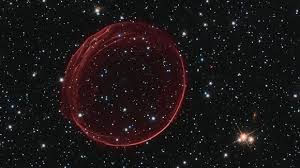THE INFORMATION PARADOX IN AN: TOWARDS A FUNDAMENTAL DESCRIPTION OF SPACE-TIME (I)
- planck
- Aug 11
- 5 min read
In recent years, a series of theoretical studies have appeared that include very important advances toward resolving one of the deepest and most persistent enigmas of fundamental physics: the black hole information paradox. Resolving this paradox will likely bring with it advances in what is considered the "holy grail" of fundamental physics: the true nature of space-time. In this two-part series, we will try to explain, step by step, what these advances consist of, why they are important, and what implications they have for our knowledge of the Universe around us. Although it may seem incredible, human beings, armed only with the power of physics and mathematics, can achieve things that, by all accounts, seem far beyond the reach of the human mind, things that seem like "science fiction." In fact, fundamental physics only uses the language of mathematics; if it used a more "familiar" language, perhaps it would tell us something like this:
Information, qubits and quantum entanglement
We'll start with the most basic (but perhaps also the most important) concept: the concept of information in quantum mechanics. Let's take a fundamental particle, for example, an electron. The electron's spin can only take two values: +1/2 (spin up) or -1/2 (spin down), but we can't predict which of these values we'll measure; we can only predict its probability. The probability of measuring one or the other value can take any value between 100% (+1/2) and 100% (-1/2). This can be visualized using what is called the Bloch sphere:

At point A the probability of measuring state 1 is 100% while at point D we have a 100% probability of measuring state 0 . When the probability is at any point between A and D we say that the wave function is in a superposition state of states "1" and "0" . At point B we have a 75% probability of finding state 1 and a 25% probability of finding state 0, this is why we say that the degree of entanglement between A and B is low. At point C the entanglement will be maximum: 50% probability of finding one or the other state.
We can consider the wave function of a single electron, represented by the graph above, as the basic unit of information, commonly referred to as a "Qbit." This is the fundamental unit of information in our Universe and, as we will see, is likely the key to understanding the true nature of spacetime.
To define what is called entanglement entropy (EE), we need two systems. Let us now consider two qubits A and B. Now, the possible states (the Hilbert space of the system) are not just two but four: (00), (01), (10), (1,1). As in the previous case, we can define a Bloch sphere for each possible outcome, so the system can be anywhere on the sphere between each of the possible outcomes. We can now precisely define entanglement entropy: the EE between two quantum systems A and B measures the number of entangled bits between A and B. The EE between two systems is defined as:

Where:

is the reduced density matrix of A. Roughly speaking, this matrix "counts" the number of degrees of freedom shared between A and B.
Information inside a black hole
The brilliant physicist Stephen Hawking not only demonstrated that black holes (BH) radiate energy, he also calculated the entropy they contain. This entropy, written in natural units, is: A/4. Where A is the area of the black hole's horizon.
Entropy measures the number of "microstates" in a system; therefore, it is a measure of the maximum possible information storage capacity. In fact, NAs are the objects that possess the maximum possible information contained within a given space-time region. The existence of NAs implies the emergence of a fundamental paradox, a paradox rooted in the deepest foundations of fundamental physics: since Hawking radiation is completely thermal and therefore carries no information, NAs must destroy the information in our Universe forever. However, this fact contradicts the most fundamental principles of known physics, including the laws of quantum mechanics and the conservation laws of classical physics. How can we resolve this contradiction?
One way to study information in black holes is by analyzing entanglement entropy. If information is conserved, an evaporating black hole should follow the so-called Page curve:

Source: Quanta Magazine
Initially, the entanglement entropy (orange curve) between the NA and the exterior is zero. Once the NA begins to radiate, the entropy increases because the Hawking radiation is entangled with the interior of the NA. We also know that at the end of the evaporation process, the NA disappears, so the EE must be zero. This means that at some intermediate instant , the EE must reach a maximum and begin to decrease. This instant occurs at the so-called Page time. At Page time, the EE of the Hawking radiation is equal to the EE of the black hole. Something very unusual must happen at that instant: from that moment on, if information is conserved, the entanglement entropy must decrease again. But how is this possible if the NA continues to radiate? What happens at that instant?
An extraordinary phenomenon in Page's time
The answer to the previous question is fascinating, and it's even likely that its answer could initiate a whole "mini-revolution" in fundamental physics. Physicists have discovered that a kind of "phase shift" occurs during the Page time: a "special zone" forms in the outermost region of the black hole (in the inner region near the horizon). This special zone is called an "island." The island's microstates and their associated entropy are no longer part of the black hole (as we will see in the next article, the island's microstates are no longer holographically encoded at the edge of the NA), which is one of the keys to resolving the information paradox. But how does this actually happen? How is it possible for the island to "escape" from the black hole? The details of how this happens are fascinating and will be analyzed in the next article. These details include some of the most cutting-edge phenomena in modern physics: AdS/CFT, entanglement, holography, wormholes, and bulk reconstruction.
Although these details are not yet fully understood, they seem to point to the existence of subtle nonlocal effects. As we will see in the second part of this article, this work suggests that one of the most fundamental components from which space-time "emerges" is quantum information. Therefore, the key question that remains to be answered is: In what fundamental physical components or entities is this information stored?
Sources: The most famous paradox in Physics nears its end ,Introduction to Entanglement Entropy , Entanglement wedge reconstruction and the information paradox








Comments